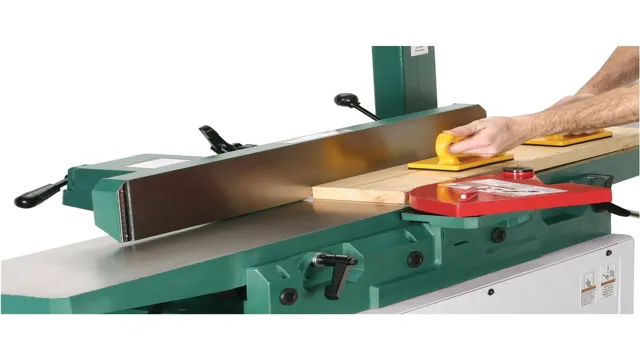
Welcome to the world of woodworking, where crafting beautiful, functional pieces of furniture is both an art and a science. One of the key tools you’ll need in your arsenal is a jointer, and one type of jointer you’ll encounter is the parallelogram jointer. This versatile machine is ideal for creating flat, smooth surfaces on your wood, no matter what type of grain or shape it may have.
But what exactly is a parallelogram jointer, and how does it work? Essentially, it’s a type of jointer that uses a parallelogram-based lifting system to adjust the infeed table. This allows for smoother, more precise cuts, especially on stock that has an uneven thickness. Instead of using a traditional helical cutterhead, a parallelogram jointer typically has straight knives that can be easily sharpened and adjusted for height.
Some woodworkers prefer parallelogram jointers over other types of jointers because of their ability to handle difficult grain patterns and produce less tear-out. However, they can be more expensive and require a bit more maintenance than other jointers. It’s important to understand the ins and outs of a parallelogram jointer before investing in one, and to know how to properly set it up and use it for the best results.
Whether you’re a seasoned woodworker or just starting out, understanding the intricacies of a parallelogram jointer is crucial to achieving professional-level results. With the right knowledge and technique, you can use this tool to create perfectly flat, smooth surfaces on your wood and take your woodworking skills to the next level. So, let’s dive in and explore the world of the parallelogram jointer!
What is a Parallelogram Jointer?
A parallelogram jointer is a woodworking tool that is used to flatten, square and smooth rough lumber so that it can be used in various woodworking projects. It works by using a table with two parallel beds that can be adjusted at a variety of angles via the parallelogram mechanism. This mechanism allows for a highly precise and stable table movement that can effectively flatten and square lumber effectively.
The infeed table is adjusted to precisely match the height of the cutting head and the outfeed table is then adjusted to the desired height which gives a consistent depth-of-cut across the entire piece of lumber being jointed. The resulting square and smooth boards are then ready to be used in furniture or other woodworking projects. By utilizing a parallelogram jointer, woodworkers can create precise and aesthetically pleasing projects that will stand the test of time.
Definition and Functionality
A parallelogram jointer is a woodworking tool used to smooth and flatten rough edges of boards, creating a straight, seamless edge. This jointer is an essential tool for creating high-quality, precise woodwork. The tool functions by using parallel blades mounted on a rotating cutter head to remove small amounts of wood from the board’s surface.
Parallelogram jointers are preferred over traditional jointers due to their ability to adjust the cutting head’s angle, allowing for precise cuts at different angles. They also have a greater cutting depth, making them more efficient and effective. Whether you’re a DIY enthusiast or a professional woodworker, having a reliable parallelogram jointer is crucial in achieving quality woodwork.

Parts and Components
A parallelogram jointer is a woodworking machine used to smooth and flatten the surface of rough lumber. Its name comes from the shape of its cutting head, which contains four blades arranged in a parallelogram formation. As a board is fed through the machine, the blades rotate rapidly, shearing off a thin layer of wood with each pass.
The parallelogram jointer is a versatile tool, capable of producing flat, straight edges and faces, making it an essential component of any woodworking workshop. Whether you are a professional carpenter or a DIY enthusiast, a good quality parallelogram jointer can make all the difference when it comes to creating high-quality, precise cuts. With its robust construction and ease of use, it is no wonder that the parallelogram jointer is such a popular tool among woodworkers of all levels.
Benefits of Using a Parallelogram Jointer
If you’re in the market for a jointer but aren’t sure which type is best for you, consider a parallelogram jointer. This type of jointer features a unique four-bar linkage system that allows for a smoother and more precise cut compared to traditional jointers. With a parallelogram jointer, you’ll get a larger cutting capacity and more accurate cuts thanks to its stable and sturdy design.
In addition, a parallelogram jointer also offers easier adjustments, making it more user-friendly than other models. Whether you’re a professional woodworker or a DIY enthusiast, a parallelogram jointer is a great investment that will help take your projects to the next level. So, if you’re looking for a high-quality jointer that offers stability, precision, and ease of use, consider a parallelogram jointer for your next purchase.
Accurate and Precise Woodworking
When it comes to woodworking, accuracy and precision are essential for achieving top-notch results. A parallelogram jointer is a perfect tool to help you achieve that desired outcome. The benefit of using a parallelogram jointer is that it operates with great efficiency, providing you with clean and flat surfaces that are free from any defects.
Additionally, this tool has a unique design that allows it to adjust the table height more easily. As a woodworker, this will save you time, allowing you to work straight away without having to fuss over adjustment issues. Another tremendous benefit is that you can use this tool on both hard and softwood, and it is perfect for cutting bevels at various angles.
Overall, the parallelogram jointer is an excellent addition to your arsenal of tools in terms of giving you accurate and precise results every time.
Versatility and Efficiency
If you’re looking for a versatile and efficient woodworking tool, then a parallelogram jointer may be just what you need. With its unique parallelogram design, this jointer allows you to easily adjust the depth of cut and angle of the cutterhead, giving you precision and control over your work. Additionally, the parallelogram design ensures that the cutterhead and table remain parallel, resulting in smoother and more consistent cuts.
And with its powerful motor and large cutting capacity, you can tackle even the toughest of hardwoods with ease. So whether you’re a professional woodworker or a DIY enthusiast, a parallelogram jointer can help you achieve great results with minimal effort.
Ease of Use and Maintenance
If you’re looking for a jointer that’s easy to use and low maintenance, a parallelogram jointer might just be the perfect option for you. Unlike other jointers that require frequent adjustments or calibration, a parallelogram jointer has a unique parallelogram-shaped mechanism that ensures the tables stay perfectly parallel. This means you won’t have to spend as much time adjusting the tables or worrying about accuracy, which can save you a lot of time and frustration in the long run.
Additionally, many parallelogram jointers have easy-to-access blades that can be changed or sharpened without too much hassle. So if you want a tool that’s both accurate and user-friendly, a parallelogram jointer could be your best bet.
Choosing the Right Parallelogram Jointer
If you’re looking for a high-quality jointer to help you achieve a precise and smooth finish on your woodworking projects, then a parallelogram jointer might be exactly what you’re looking for. A parallelogram jointer is a type of jointer that uses a parallelogram design to maintain a consistent height throughout the cutting process. This means that you get a more even cut, with fewer snipe marks or variations in thickness.
When choosing a parallelogram jointer, there are a few things to consider, such as the size and power of the motor, the width of the blades, and the overall build quality of the machine. You’ll also want to take a look at user reviews and ratings to see how well the jointer performs in real-world situations. With the right parallelogram jointer, you can tackle even the toughest woodworking projects with ease and confidence, knowing that you’ll get the precision and consistency you need for a professional finish.
Considerations to Make
When it comes to choosing the right parallelogram jointer, there are several important considerations to make. The first consideration is the size of the jointer. You need to consider the size of the boards you will be using, as well as the space you have available in your workshop.
Too small of a jointer will limit your workspace, while too large of a jointer can be cumbersome and expensive. The second consideration is the brand of jointer. Different brands have different features and specifications, so it’s important to do your research and choose a brand that meets your specific needs.
Finally, you’ll need to think about the price. While price is certainly not the only consideration when choosing a parallelogram jointer, it is an important one. Consider your budget and determine how much you’re willing to spend on a quality jointer that will meet your needs.
With these considerations in mind, you’ll be able to choose the right parallelogram jointer for your workshop.
Features to Look Out For
When you’re looking at purchasing a parallelogram jointer, there are a few key features to keep in mind to make sure you’re getting the right one for your needs. One of the most important factors to consider is the size of the machine. You’ll need to think about both the width of the cutter head and the length of the bed, as these will determine the size of the wood you can work with.
Additionally, you’ll want to look for a jointer with adjustable infeed and outfeed tables, which will allow you to fine-tune the depth of cut and ensure that your project comes out perfectly smooth and flat. Other important features to consider include the power of the motor, the quality of the blades, and the durability of the overall construction. Researching and selecting a good parallelogram jointer based on these factors can help you achieve a top-quality finish on all of your woodworking projects.
Conclusion
In summary, a parallelogram jointer is like a magical tool that allows you to straighten, flatten and square your boards with ease, all while maintaining consistent and accurate results. It’s the lovechild of precision engineering and woodworking, an essential part of any serious woodworker’s arsenal, and if you’ve never used one before, you’re missing out on the joys of perfectly joined, smooth-as-silk boards. So, in the wise words of Ron Swanson from Parks and Recreation: “Never half-ass two things.
Whole-ass one thing. And that one thing, my friends, is the parallelogram jointer.”
FAQs
What is a parallelogram jointer?
A parallelogram jointer is a woodworking tool used for flattening and smoothing the surface of wooden boards.
How does a parallelogram jointer work?
A parallelogram jointer works by using rotating blades to remove material from the surface of the board, creating a flat and smooth surface.
What are the advantages of using a parallelogram jointer?
The advantages of using a parallelogram jointer include achieving flat and smooth surfaces on wooden boards, which is important for proper woodworking and furniture making.
Can I use a jointer to create beveled edges on a board?
No, a jointer is used for creating flat surfaces only. To create beveled edges, a different tool such as a table saw or a router is needed.
How often should I sharpen the blades on my parallelogram jointer?
It is recommended to sharpen the blades on your parallelogram jointer after every 10-15 hours of use or when you notice a decrease in the quality of the cut.
Can a parallelogram jointer be used on different types of wood?
Yes, a parallelogram jointer can be used on different types of wood, including hardwood, softwood, and engineered wood.
How do I maintain my parallelogram jointer?
To maintain your parallelogram jointer, you should keep the blades sharp, clean the surface and dust collection system regularly, and lubricate moving parts as needed.







